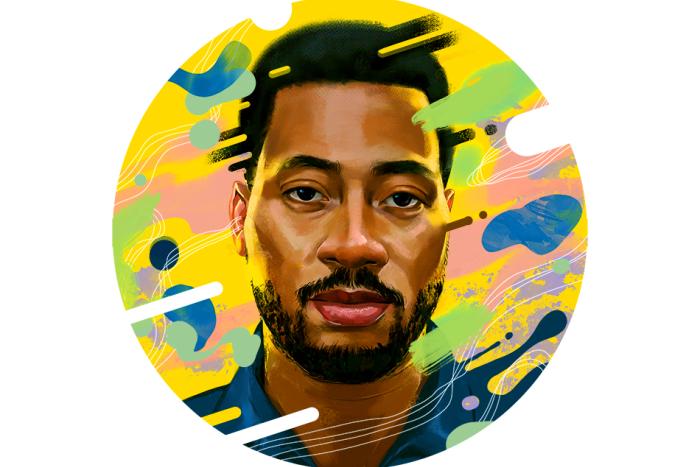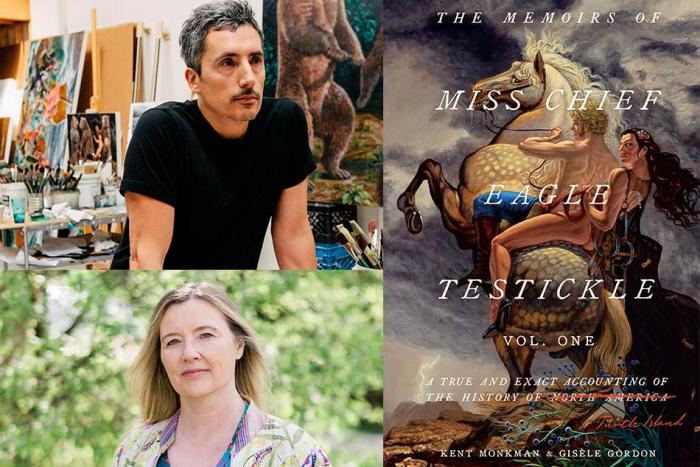I have the fuzziest recollection of the first time I heard a land acknowledgement, likely at an artist talk at the Art Gallery of Ontario in 2016 or so. I would’ve been around thirty-five years old, and when the event host recited the acknowledgement, I was…confused.
It turned out that this was my first of many land acknowledgements I would experience. They would roll out time and time again, in educational, entertainment and sporting spaces, gaining steam over the last decade. But in 2016, I hadn’t yet realized that these speeches were meant to show a dedication to the Truth and Reconciliation Commission of Canada’s Calls to Action.
I grew up on the Six Nations of the Grand River, a reservation whose very existence speaks to a legacy of broken promises between Indigenous people and settler Canada. My reservation’s distinction and source of pride, that it gathered many Haudenosaunee groups who agreed to live peacefully together, is tangled up with the dishonour of the reservation system and the Indian Act. So moving to Toronto in 2005 and coming to understand that land acknowledgements were meant to address that history felt like an insufficient step in reconciliation. As I grew older and became a parent, I started to have conversations with my children and my own parents to understand the strange and conflicted place these acknowledgements hold in our lives.
*
Land is a lesson that many Indigenous people learn from our earliest days in school.
In grade one, in the one-room portable that was my classroom on the reserve, I learned about our origin story. For Mohawks and the Haudenosaunee people, that story is centred around a woman who lives in the sky who falls from the heavens into a water-covered planet.
With the assistance of many water animals, Sky Woman turns pieces of mud from the bottom of the ocean into land, which expands from a turtle’s back to become North America. In our lessons, we learned that the continent is called Turtle Island.
Sprinkled among math and reading were lessons about treaties, and how the land we lived on—Six Nations of the Grand River, in Southern Ontario—had come to be ours.
I remember learning that we, the Haudenosaunee people, originally came up through what is now New York State before settling here, an hour and twenty minutes southwest of Toronto. We also learned how we used to live in longhouses and were a matrilineal, comprehensive society before the settlers arrived. Those settlers had a very different understanding of land ownership than we did.
Whenever I asked my parents questions about our house, the one where I lived from birth until I moved away for university, they would explain that the land had been given to us by my paternal grandfather. Parcels of land surrounding our long gravel driveway housed my aunts and uncles, cousins, and grandparents. My parents were always clear that as Indigenous people, we didn’t believe in the ownership of it, and that this belief was at odds with others who lived off-reserve.
Under the Indian Act, a reserve is considered to be “held by Her Majesty for the use and benefit of the respective bands for which they were set apart, and subject to this Act and to the terms of any treaty or surrender, the Governor in Council may determine whether any purpose for which lands in a reserve are used or are to be used is for the use and benefit of the band.”
We may use them, reside on them, benefit from them, yet not own them in the way that land ownership operates across the rest of the country.
The settlers believed that you could buy and sell land. To them, you could own it, instead of being its protectors. Or rather, they could own it. We could not.
Again, from the Indian Act: “No Indian is lawfully in possession of land in a reserve unless, with the approval of the Minister, possession of the land has been allotted to him by the council of the band.”
My community of 12,848 people lives on a 48,000-acre parcel of land. In 1784, in agreement with Frederick Haldimand, the general and commander-in-chief of His Majesty’s Forces in the province of Quebec and territories depending thereon, 950,000 acres were set aside for the Six Nations people. We live on a fraction of what was promised.
If you ask most adults from Six Nations about the Haldimand Treaty, they can quote you this portion: “...Six Miles deep from each side of the River.” It often comes up conversationally, a lament for how much more our community could be or how much further along we as a people would be if this promise hadn’t been broken. It also often illustrated where our general sense of mistrust concerning government bodies stemmed from. The phrase refers to the swath of land the treaty set aside: six miles on either side of the Grand River, from Lake Erie to the river’s headwaters, “which Them and Their Posterity are to enjoy for ever.” Even though it’s from over two hundred years ago, that quote continues to be passed on from one generation to the next. What we were promised, what we could’ve had.
Within the next decade, the land in that tract was parcelled off to other settlers. Despite the Six Nations agreeing in 1796 to share 302,907 acres, with the intention to use the revenue from the sale for the care and maintenance of the land, the Crown did not hold up their end of the bargain. Six Nations saw very little, if any, real revenue from those sales.
I didn’t learn all the nuts and bolts of the treaties until adulthood, but I was always aware of the six miles from the mouth of the Grand River to Lake Erie.
*
Our section of the family land, the one that I lived on with my mom, dad, and older brother, had a vast backyard with trees, and a creek that we would skate on when it froze over during the winter. My dad would show my brother and I how to paint our skin with the dandelions that bloomed everywhere, and how a certain type of weed that popped up on our lawn made purple buds whose bottoms were sweet to the taste. He also taught us how to place a long thick blade of grass in between our thumbs to create a honking sound when we blew. I’d take my Barbie dolls and play with them outside in the big expanse of our yard, or attempt to ride my bike down the long gravel driveway. Returning now, my parents will often walk my kids and me to the outer edges of the backyard to see what the trees are growing—nuts and fruits.
We often saw coyote, rabbits, wild turkeys, and plenty of neighbourhood dogs roaming freely across the yard. One morning while I was getting ready for high school, a family of deer appeared in the backyard and my dad and I froze, watching them from the kitchen window. We silently marvelled at them and their proximity, neither of us wanting to spook them.
It wasn’t until I was an adult, living in a major city, that I realized the depth of my connection to the land. When I return to that home to see my parents, as a visitor with my husband and two children, my favourite part is the countless hours we spend in the backyard. My kids climb trees, run much longer distances than they’re able to in our fenced-in backyard in the city, and roll around in the grass. As I watch them, I think how impossible it is to take the whole history of their relationship to—and separation from—their land and condense it into a tightly worded sentence or two, to be recited before sports games or by schoolchildren in classrooms across the country.
*
Nothing written in the Truth and Reconciliation Commission’s Calls to Action report actually requires a land acknowledgement to be spoken. The closest thing I could find within the 94 calls to action reads: “We call on the federal government to draft new Aboriginal education legislation with the full participation and informed consent of Aboriginal peoples. The new legislation would include a commitment to sufficient funding and would incorporate the following principles,” including “vii. Respecting and honouring Treaty relationships.”
The main focus of the recommendations is on education: closing funding gaps between on- and off-reservation schools; improving Indigenous students’ success rates; making sure all students receive culturally appropriate lessons; and giving credit for courses in Indigenous languages.
I have an interesting vantage on the ways these recommendations have, and have not, been implemented: I had an on-reserve elementary education, and now have two children in an off-reserve elementary school in Scarborough. Additionally, multiple friends and family members are teachers at both on- and off-reserve schools.
I know that despite requests for culturally appropriate lessons, teachers aren’t given enough guidance. They explicitly tell me this. I’ve wound up being an unofficial consultant on lessons for kindergarten up to high school, unexpectedly fielding calls about where to source information on the Haudenosaunee people, and what culturally relevant museums or institutions they should have on their radar. I’ve been called on to make Indigenous book recommendations for everything from elementary schools to universities, by those stocking the shelves in their libraries. At parent-teacher meetings, my kids’ teachers have encouraged me to come into class and speak about literally anything Indigenous—that’s how desperate some of them are for teaching materials.
Once, my kid brought home an assignment that asked her to list what country she was from, and those her grandparents and great-grandparents were from. It was clearly meant for those who could proudly say their family came from faraway countries like Nepal, Sri Lanka, Greece, or Korea. On my daughter’s sheet, for each line related to me, my parents, or my grandparents, we put Canada. Then Canada again. Then Canada again. There was no room for First Nations, Métis, or Inuit heritage. It felt like we were ignored or discounted.
Sometimes I see schoolwork come home about the various First Nations, Métis, and Inuit groups that live in this country. But I know that the main day-to-day engagement my kids and their peers have with the history of Indigenous people is through the land acknowledgement, which is recited every morning before “O Canada” plays.
My daughter and her friend can recite the land acknowledgement verbatim. They performed it one night when we had a bunch of friends over, as if it were a party trick.
“We acknowledge we are hosted on the lands of the Mississaugas of the Anishinaabe, the Haudenosaunee Confederacy and the Wendat. We also recognize the enduring presence of all First Nations, Métis and the Inuit peoples,” they said, in unison. Our friends, all Greek like my husband, joined me in surprise and amusement, laughing at this impromptu performance.
It took until grade three for my daughter to understand that she is a member of the Haudenosaunee Confederacy that is mentioned each day, and that she is an enduring First Nations presence. (My six-year-old is still figuring out more basic things, like how to spell his last name.)
When I ask her what she thinks the daily land acknowledgement at her school really means, she says, “It makes people think about the land and be grateful.” She also equates the national anthem, particularly the line that includes “Our home and native land,” to the idea that the land is beautiful, and that we should be thankful to have it. To her, they are one and the same.
“If they stopped doing them, how would you feel?” I asked both my kids.
“Upset, because I like it,” said my daughter.
“I would feel good, because I could sit,” my son said, before confirming that students are asked to stand for it. It’s clearly a collection of words that are way too sophisticated for him to understand at the moment, solidifying that there are surely better ways to engage younger children in this concept.
I then tell them both that their grandparents—whom they call Totah (Mohawk for “grandmother”) and Bubba (the name my mom used for her own grandfather)—heard their first land acknowledgement when they came to my daughter’s first Christmas concert at school in 2018.
My daughter gasps. I then explain that they don’t do land acknowledgements on the reserve.
“Oh yeah. That makes sense,” she replies.
My Greek husband is tickled by the rise of land acknowledgements. He often references a 2004 Dave Chappelle joke, about how Chappelle met a Native person in a Walmart and told them “I studied you in Social Studies,” indicating how rare our presence was. Whereas now, a film at TIFF called Dicks: The Musical is unable to start rolling without a land acknowledgement. He deliberately leaned over to my parents at the aforementioned Christmas concert, to ask them if they’d heard one of those before.
Baffled, they shook their heads no.
I couldn’t help but notice the disconnect: for years, daily lip service has been paid to a group of people who have absolutely no idea they and their history are being acknowledged at all. But I suppose that part isn’t really the point.
*
Several times, I’ve been asked to read a land acknowledgement on a stage. Often, I decline to say it, and inform the person who has asked me to do so of the reasons why: that the exercise is meant for non-Indigenous people to learn who was on this land, and that I want them to do that work. Other times, I have rewritten the text to say that I am Mohawk from Six Nations, and the Haudenosaunee people I descend from are included in the treaties that these acknowledgements often mention, and ask the audience to learn more.
In these moments, I often think of what I know about our relationship to the land. Both non-Indigenous cultural anthropologists and historians and Indigenous peoples’ oral histories have documented references to how we were caretakers of the land. We lived on it, were sustained by it, and learned from it for so long that we became experts. Through my journalism work, I’ve spoken to people living in Nunavut who used to be able to predict the day that the water would freeze solidly enough to traverse, and to people on the West Coast who knew exactly when to conduct a controlled burn of the land. This practice, once banned, ensures renewed plant growth that creates food for animals and prevents wildfires.
The research and communication work that I and so many other Indigenous people are doing is an attempt to inform our audiences about how that connection still endures. It continues the conversation that a land acknowledgement can only begin. And maybe that’s the problem with land acknowledgements: not enough people understand that they’re not the end of the discussion.
They're meant to give both the speaker and listener a moment of reflection, to stop what they’re doing and think about the space they’re occupying: who occupied it before, and who occupies it now.
When further conversation isn’t encouraged, it’s easy for this to become a mindless recitation. Some Indigenous providers of land acknowledgements have even admitted that they regret having written them.
In 2019, Hayden King, who gave Toronto Metropolitan University its land acknowledgement, told Rosanna Deerchild, the host of CBC’s Unreserved: “I started to see how the territorial acknowledgement could become very superficial and also how it sort of fetishizes these actual tangible, concrete treaties. They're not metaphors—they're real institutions, and for us to write and recite a territorial acknowledgement that sort of obscures that fact, I think we do a disservice to that treaty and to those nations.”
Like many of the other authors, King felt rushed to keep up with the groundswell of support for land acknowledgements, and didn’t have the benefit of time to think them through. Though they’ve quickly become ubiquitous, we really haven’t been saying land acknowledgements for very long—they’re still in their infancy, and they shouldn’t be thought of as fixed statements. They should always be revisited, updated, and maintained—treated just as the land itself must be.
King suggests one such shift: that we create a framework for a land acknowledgement that could be filled in by the non-Indigenous speaker. The onus would be on them to learn about the land’s history, and do the work of writing an acknowledgement instead of being provided with one.
When I ask my mom now what she thought about hearing an acknowledgement recited for the first time, the only thing she’ll say on the record is that she believes the land acknowledgements are nice. She refuses to have any more of her thoughts in print. If I were to speculate on why she wants to keep those thoughts to herself, I’d say that she doesn’t want to sound ungrateful for land acknowledgements, and she also does not want to fire off a laundry list of other things that the country could be better served by attending to.
Instead, she’ll just say that she thinks they’re nice.






